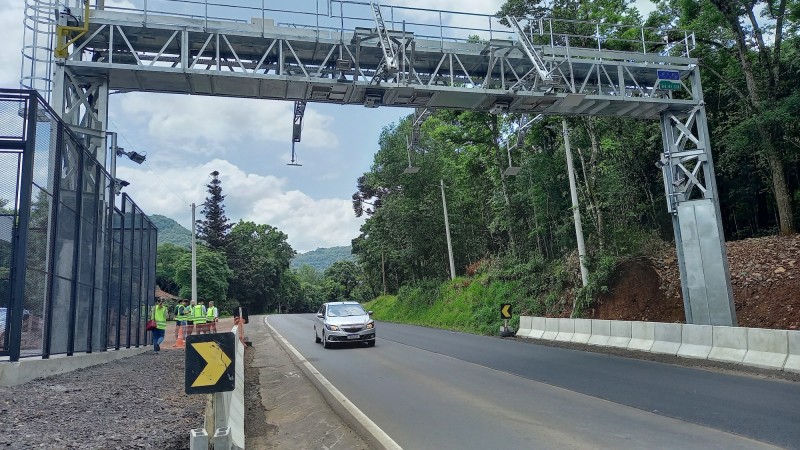The National Land Transport Agency (ANTT) presented on Monday (27) the balance of the first 14 months of operations Free flowToll collection model without physical plazas. Tests conducted at the three yards on BR-101, operated by CCR RioSP, were rated as satisfactory. However, demands for technological modifications and communication with users have been observed, with the main aim of reducing defaults, a trend that follows the model.
In the Free flowVehicles are identified either by electronic tag (TAG) or by vehicle license plate. The goal is to provide greater flexibility and smoothness to the user and consumer on the highway.
Tests with CCR RioSP will remain under analysis for another year. Next, issues such as default levels must be evaluated to determine the usefulness of the model.
Continues after ad
Despite the overall positive evaluation by ANTT and CCR,… Free flow It was the target of a large volume of complaints. In April, the Federal Court, after provocation by the Public Ministry, decided to suspend 32,000 fines applied to users who, in theory, had not paid the fees. The MP says that it turns out that the system has failed.
At a press conference on Monday, ANTT director Luciano Lourenco said part of the problem of undeserved fines was due to the system’s transition last year. However, he says the MP’s complaints are superficial and that ANTT itself was actually censoring and suspending assessments due to errors in the system.
“It is important to note that when we charge a toll on a toll freeway, there is a natural resistance in the first few months. “So I think this action (taken by the MP) was more due to users resisting having to pay tolls than to the free-flowing system Same,” Lourenco says.
shortening
In free flow, those who do not pay for the tag are later charged a fee, with a 15-day period for payment. After this period, in addition to paying the fare, a serious traffic violation is marked with a fine of R$ 195.23.
Since the beginning of operations, 15.9 million vehicles have traveled along this stretch. Of these, 772,000 were fined for default, and 38,000 were voided after being verified as “miscellaneous errors”, such as duplication of invoices and payments made but not verified. Default rates in the concession were 12.49% in March 2023, reaching a low of 8.96% in January this year, and in March they reached 9.70%.
“At the beginning of the conversations about Free flow, we were talking about up to 40% defaults. “For a country that did not have this system before, on a highway that did not have any tolls, the current levels are fantastic,” says Luciano Lourenço.
Continues after ad
“We have one year of evaluation to go and we will still have another year. It is possible that the current default rate will decline further. In more mature countries, such as Chile, it is around 5%. Fernando Barbil Fetosa, Director of Road Regulation at ANTT, says “Getting to zero is an experiment that has not proven its applicability at the international level.”
Enlarge – widen
Regarding the possibility of implementing the system on new highways, the representative of CCR Rodovias, Kleber Chenellato, present at the press conference held by ANTT, says that, firstly, it is necessary to understand that free flow may not be applicable for all highways, demanding the evaluation of issues such as Characteristics and size of vehicles traveling on the granted extension.
However, he sees strong potential for the model to move forward. CCR Group currently owns 11 highway concessions. “At the rates we are seeing in BR-101, if this customer behavior continues for other franchisees, with compliance increasing all the time, we will be able to continue with almost all projects,” says Chenellato.
Continues after ad
“ANTT has not reached a conclusion to change all toll plazas to free flow. We have parks in rural areas, with a low number of vehicles and still in a period of depreciation. However, we have other toll plazas worth studying. It is an excellent tool, but We have to study it case by case.”
technology
“The technology was a concern at first and that has been overcome. Our experience has been challenging, but we celebrate. “We have been able to validate a lot of things that actually bring efficiency to this model,” said CCR Rodovias representative Kleber Chenellato, who was present at the conference. Journalist held by ANTT.
For Chenellato, the key to moving forward and ensuring the necessary revenue for operations is improving communication with drivers. In this sense, one of the demands is to allow automatic triggering of SMS messages when the driver passes on the highway. Currently, the driver can be notified through the Digital Traffic Card (CDT) and CCR applications.
Continues after ad
There is still a need to expand specific signage to guide drivers about the charging model and payment alternatives, in relation to the bottlenecks highlighted by Cléber Chinnellato. Another request, which has already reached an advanced stage of discussion, is to extend the payment period from 15 to 30 days. Furthermore, ANTT is developing a unified system to allow drivers to access free-flowing fees from all dealerships, and is considering expanding the model in the coming years.

“Music fanatic. Professional problem solver. Reader. Award-winning tv ninja.”






More Stories
Couple retakes glacier photo after 15 years, surprised by changes: ‘It made me cry’
Two killed in hotel collapse in Germany – DW – 07/08/2024
Lula speaks for half an hour on phone with Biden about Venezuela’s electoral impasse | Politics